Tunisia
Kerkuane
The Punic Town of Kerkuane and its Necropolis show the urban planning and architecture of the Phoenician-Punic Empire.
The city was never rebuilt after its destruction in 255 BCE and therefore (unlike Carthage) has no mixing with later Roman construction. The harbor, the street plan, residential areas, squares, temples and the remains of the large cemetery have been uncovered. The houses were built to a standard plan by a sophisticated notion of town planning.
Community Perspective: located in a very nice coastal setting, only the foundations of the town are left and it needs about an hour to explore. Els has provided directions to the less-obvious second location.
Site Info
Official Information
- Full Name
- Punic Town of Kerkuane and its Necropolis (ID: 332)
- Country
- Tunisia
- Status
-
Inscribed 1985
Site history
History of Kerkuane
- 1986: Extended
- To include Necropolis of Arg al-Ghazwani
- 1985: Inscribed
- Inscribed
- Type
- Cultural
- Criteria
- iii
Links
- UNESCO
- whc.unesco.org
- Official
-
- tunisiepatrimoine.tn — Ministry of Cultural Affairs: Kerkouane
- Related
-
- livius.org — Articles on ancient history: Kerkouane
All Links
UNESCO.org
- whc.unesco.org — whc.unesco.org/
Official Website
- tunisiepatrimoine.tn — Ministry of Cultural Affairs: Kerkouane
Related Resources
- livius.org — Articles on ancient history: Kerkouane
Community Information
- Community Category
- Archaeological site: Phoenician
Travel Information
Tunisia hotspot
Recent Connections
-
Perfect Inscriptions
1985 -
Irrigation and drainage
"The part of the city, now uncovered, p… -
Baths
" One of the most remarkable features o…
Connections of Kerkuane
- Geography
-
-
Mediterranean shore
The archeological site borders the Mediterranean.
-
- History
-
-
Phoenician world
Important Phoenician city-state -
Punic Empire
"bears exceptional witness to Phoenician-Punic town planning" (OUV)
-
- Architecture
-
-
Mosaic art
A sanctuary has some columns preserved, and in a small atrium parts of mosaics are found. Curbstones, doorsteps, thresholds, and floors of simple mosaic layers are found all over the ruins. (wiki)
-
- World Heritage Process
-
-
Inscribed on a single criterion only
iii. to bear a unique or at least exceptional testimony to a cultural tradition or to a civilization which is living or which has disappeared -
Extended
1986: To include Necropolis of Arg al-Ghazwani -
Perfect Inscriptions
1985
-
- Human Activity
-
-
Irrigation and drainage
"The part of the city, now uncovered, proves the existence of a drainage system for rain and wastewater that was quite well developed. Sewers have been recognized in different streets. The outflow of drainage system probably ended in the sea, and care was taken as not to contaminate the underground freshwater."
-
- Constructions
-
-
Baths
" One of the most remarkable features of ancient Kerkouan is that almost all houses are equipped with elaborate bathrooms. Shoe-shaped bathtubs made from red concrete are the most typical model, with a seat for the bather." -
Protective Shelters
The House of Tanit is under a protective shelter. -
Necropolises
Necropolis of Arg el Ghazouani
-
- Timeline
-
-
Built in the 3rd century BC
This Phoenician city was probably abandoned during the First Punic War (c. 250 B.C.) and as a result was not rebuilt by the Romans. The remains constitute the only example of a Phoenicio-Punic city to have survived (AB).
-
- WHS Hotspots
-
-
Tunisia hotspot
126km (best by car)
-
- Visiting conditions
-
-
Foreigner prices
Resident: 5 Dt, Non-resident: 8 Dt
-
News
No news.
Recent Visitors
Visitors of Kerkuane
- Alberto Rodriguez Gutierrez
- Alexander Lehmann
- Ana
- Atila Ege
- BaziFettehenne
- Boj
- Bram de Bruin
- Christer Sundberg
- Christian Wagner
- Christoph
- Christravelblog
- Corinne Vail
- ctravel
- czesioszpachelka
- Dimitar Krastev
- Dolemite92
- Els Slots
- Erik Jelinek
- Eva Kisgyorgy
- Fan Yibo
- Feldhase
- Felicité
- GeorgeIng61
- Harry Mitsidis
- H Beswick
- henryjiao18
- Iain Jackson
- Ian Cade
- Ivan Rucek
- Janos
- Jarek Pokrzywnicki
- Jawnbeary
- Joel on the Road
- Jonas Kremer
- Kbecq
- La Concy
- Loic Pedras
- Ludvan
- Luis Filipe Gaspar
- marcel staron
- marc Rouserez
- Martina Rúčková
- Mikko
- Milan Jirasek
- Miloš Tašković
- MoPython
- Naim Y
- Nihal Ege
- PabloNorte
- Petteri
- Philipp Peterer
- Priyaranjan Mohapatra
- Randi Thomsen
- Roger Ourset
- Roman Bruehwiler
- Sergio Arjona
- Shandos Cleaver
- Ssong.x
- Stan
- Stanislaw Warwas
- Svein Elias
- Szucs Tamas
- Taotao Chen
- Tarquinio_Superbo
- Thomas Buechler
- Thomas van der Walt
- tony0001
- triath
- WalGra
- Wojciech Fedoruk
- Zach
- Zoë Sheng
Community Reviews
Show full reviews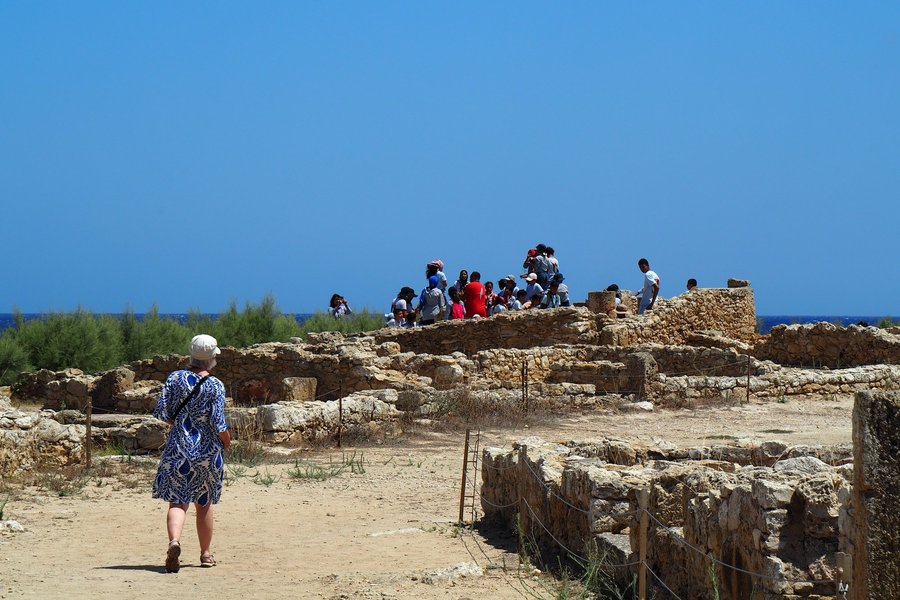
From Sidi Bou Said, we circled Cape Bon clockwise to reach Kekouane by midday. The location is well signposted on the main road to Kelibia.
The site is very well equipped, with guarded parking and a small, very informative museum. The model of the Punic and exclusively Punic city is very educational and gives a good idea of the size of the city in the 3rd century BC. The number of Punic works of art presented is limited, but they are very beautifully crafted. It would seem that the excavations are not exhaustive. Do the unexcavated areas correspond to the gaps in the model?
As for the excavation site, its setting is so magnificent that one would almost want to play leapfrog with the base of the walls that remained in place: the ruins, a few trees that provide vertical counterpoint, the sea in the distance, a cloud that has come to the wrong place, the sound of the surf and the singing of Tunisian scouts in the breeze (Introductory photo). Everything is peaceful.
I'm not going to show the image of Els where we see the goddess Tanit on the ground welcoming the stranger, but it's one of the most sympathetic images that we can see on the site. I was also very surprised to see the great know-how of the builders of the time, with these sitz baths covered in red plaster and the floor coverings so accomplished!
For van life enthusiasts, it is possible to sleep in …
Keep reading 0 comments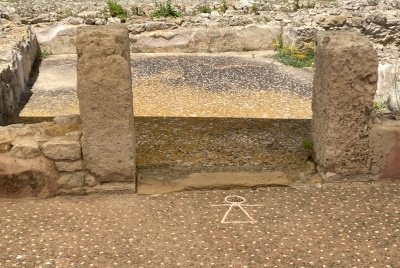
Kerkuane lies in the ‘far’ northeast of Tunisia. I went there by rental car from Bizerte, which turned out to be an ‘interesting’ drive of about 200km. It is slow going, as you have to cross numerous towns and there is a lot of slow traffic on the road including horse carts and flocks of sheep. The landscape isn’t as pretty as near Dougga, but the numerous olive groves easily outdo the ones in Andalusia. Near Erritiba, there was a nasty surprise – the road was blocked for some reason, with police around and many onlookers. I had to make a large detour to finally arrive at Kerkuane after 5(!) hours.
The archaeological site has a pleasant setting right at the sea and I welcomed the breeze that comes with it. It takes about an hour to explore. It needs a bit of TLC (or more funds), as several of the excavated parts are now overgrown with weeds. The information panels were barely readable. Under a protective shelter lies its most precious treasure: the House of Tanit, with the sign of the goddess Tanit placed in front of its entrance for good luck (pictured).
There is a 2nd location as well, a Necropolis from the 6th-3rd centuries B.C., about 5km away from the main site. It is a bit hard to find when you don’t know what you’re looking for. I made it by car to where Google Maps has it marked but saw nothing. Fortunately, Svein …
Keep reading 0 comments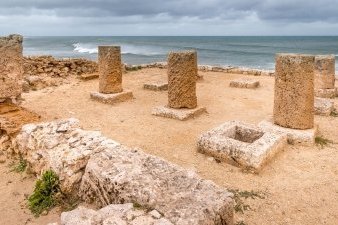
I visit Kerkouane as part of my 2 week road trip in the northern half of Tunisia. (I ticked of all the WHS/TWHS there). Kerkouane is a 2.5 hour drive from Tunis or 3 hours from Sousse. I recommend visiting it on the way from Tunis to Sousse or the other way around. Saves you driving the same road twice and Cape Bon is nice to drive around too.
It's a beautiful site and I really enjoyed walking around the site. It's only foundations left, which are in general from almost nothing up to over a meter high. The grid layout is good visitble and you get a good idea how the city must have looked like. Lots of plaster is in tact, mosaic floors (simple ones), and some houses have good signs with explanations and a 3D model how they must have looked like. Great way to explore.
I recommend walking along the coast to the back, walk the small part through the bushes too, until the wall. Then turn right along that road that went to the sea. Then again right over the main road to the main square. This way you see all. The museum on the site is beautiful too.
A small extra, go also to Kelibia Fort. It's nearby and you can manage it the same day. It's nice especially with kids.
Keep reading 0 comments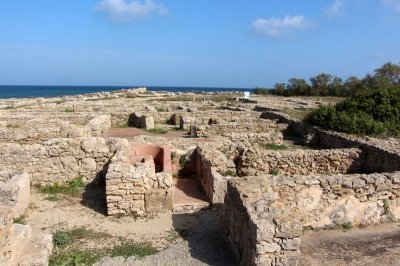
Kerkuane is one for the true collectors. The landscape is very nice in this part of Tunisia and I even saw some flamingo colonies on the way. Nevertheless, it is a bit hard to justify the combined around 5h drive to get there and back for what you see. The highlights are the bathrooms and a rather primitive mosaic. The rest are very low-level ground walls and a nice sea view. Opening times are very limited, closing at 4pm and closed on Mondays, so plan ahead. Just follow google maps to find the site. There is not much else around and very limited accommodation offers so I would not suggest staying overnight in this area. There are no motorways in this part of the country and many trucks. You will pass several cities, which further challenge your driving skills.
Keep reading 0 comments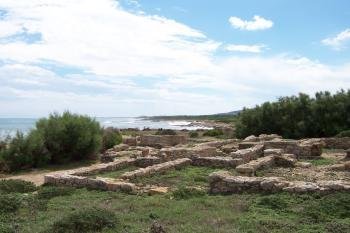
This is a really nice site to visit, it is out of the way and situated on a great piece of coastline. There is not much left (everything is less that a metre in height!) but it provides a great example of Punic towns especially good if you have seen other sites in the country which did not fair so well under the Romans! The site is right next to the sea and contains some features which you would not see at other archaeological sites such as the minimalist mosaics and almost fully intact bathrooms in every house.
The site is best reached from pleasant fishing town of Kelibia where local buses can drop you of at the turn off then it is a 1.5km walk to the site, or alternatively you could get a taxi there which should cost about 4-10TD (€2.5-7)
Keep reading 0 comments
